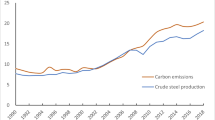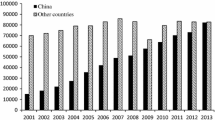Abstract
The impact of trade on the environment and the climate has become a focus of attention. Tending to develop industries with higher added values, developed countries rely on importing high energy consumption goods from developing countries, and however, some CO2 emissions are embodied in the process of import. Currently, the accounting method of the territorial responsibility used to get the international data of greenhouse gas inventories ignores the difference between domestic consumption and export demands. Thus, developing countries bear the responsibility of pollution emissions from the export. The steel industry is an important basic industry of China’s national economy as well as a vital part in the industrial system. With the expansion of trade scale, the impact of the export and import of China’s steel on CO2 emissions is growing. This paper studied the embodied CO2 emissions in the trade of China’s steel from 2005 to 2014, using the input–output model and the trade data of the China’s steel imports and exports. The results indicate that (1) the complete CO2 emissions of China’s steel industry are high. (2) The increase in the export scale makes the embodied CO2 emissions in the trade of China’s steel export increase, and (3) China is a net exporter of CO2 emissions in the steel trade. Especially after 2007, the value of China’s steel exports has been larger than that of China’s steel imports, so China had borne much CO2 emissions responsibility in the trade of China’s steel. Therefore, this paper puts forward that, in the future, the export structure of goods should be optimized into the high-tech products with the high added value, low energy consumption and low carbon emissions, and meanwhile, service industry is promoted to improve technical support to reduce CO2 emissions in the steel industry.

Source: The Wind database

Source: The Wind database, United Nations Comtrade database

Source: The Wind database, United Nations Comtrade database

Source: Chinese custom statistics

Source: Chinese custom statistics






Similar content being viewed by others
References
Brown MT, Herendeen RA (1996) Embodied energy analysis and EMERGY analysis: a comparative view. Ecolog Econ 19:219–235
China Metallurgical Planning and Research Institute (2016) Coal consumption in China’s steel industry in recent years. http://coal.in-en.com/html/coal-2319461.shtml
Chinairn (2013) Steel, energy conservation and carbon reduction is the development trend in the steel industry. http://www.chinairn.com/news/20130626/155252497.html
Du H, Guo J, Mao G et al (2011) CO2 emissions embodied in China–US trade: input–output analysis based on the emergy/dollar ratio. Energ Policy 39:5980–5987
Egilmez G, Kucukvar M, Tatari O (2013) Sustainability assessment of US manufacturing sectors: an economic input output-based frontier approach. J Clean Prod 53:91–102
Energy statistics division of National Bureau of Statistics of China (2009) China’s energy statistical yearbook 2008. China Statistics Press, Beijing
Energy Statistics Division of National Bureau of Statistics of China (2014) China’s energy statistical yearbook 2013. China Statistics Press, Beijing
Guo J, Zhang Z, Meng L (2012) China’s provincial CO2 emissions embodied in international and interprovincial trade. Energ Policy 42:486–497
Guo YL, Wu HM, Miu DL (2015) An analysis of embodied carbon in the Sino-USA trade of woody forest products. J Beijing Forestry U. (Social Sciences) 12:53–58
Hendrickson C, Horvath A, Joshi S et al (1998) Peer reviewed: economic input–output models for environmental life-cycle assessment. Environ Sci Technol 7:184A–191A
IPCC (2006) IPCC Guidelines for National Greenhouse Gas Inventorie. http://www.ipcc-nggip.iges.or.jp/public/2006gl/chinese/index.html
Jiang H, Zhang YY, Yin L (2013) The estimation of greenhouse gases emission embodied in China’s steel trade. J Changzhou U Soc Sci Edit 14:32–35
Kim Y, Worrell E (2002) International comparison of CO2 emission trends in the iron and steel industry. Energ policy 10:827–838
Lenzen M, Murray J, Sack F et al (2007) Shared producer and consumer responsibility—theory and practice. Ecol Econ 1:27–42
Li L, Lei Y, Pan D (2015) Study of CO2 emissions in China’s iron and steel industry based on economic input–output life cycle assessment. Nat Hazards, 1–14
Liu X, Wang C (2009) Quantitative analysis of CO2 embodiment in international trade: an overview of emerging literatures. Front Environ Sci Eng China 3:12–19
Liu X, Ishikawa M, Wang C et al (2010) Analyses of CO2 emissions embodied in Japan–China trade. Energy Policy 38:1510–1518
Machado G, Schaeffer R, Worrell E (2001) Energy and carbon embodied in the international trade of Brazil: an input–output approach. Ecol Econ 39:409–424
Mattila T, Koskela S, Seppälä J et al (2013) Sensitivity analysis of environmentally extended input–output models as a tool for building scenarios of sustainable development. Ecol Econ 86:148–155
Meng YH, Zhuang T (2011) CO2 emissions embodied in Sino-US trade-analysis on the top ten export goods. Asia Pac Eco 3:46–50
Minx JC, Wiedmann T, Wood R et al (2009) Input–output analysis and carbon footprinting: an overview of applications. Econ Syst Res 3:187–216
Munksgaard J, Pedersen KA (2001) CO2 accounts for open economies: producer or consumer responsibility? Energ policy 4:327–334
National Bureau of Statistics of China (2009) China statistical yearbook 2009. China Statistics Press, Beijing
National Bureau of Statistics of China (2014a) China statistical yearbook 2014. China Statistics Press, Beijing
National Bureau of Statistics of China (2014b) Statistical bulletin of the national economic and social development in 2014. http://www.stats.gov.cn/tjsj/zxfb/201502/t20150226_685799.html
Peters GP, Hertwich EG (2008) CO2 embodied in international trade with implications for global climate policy. Environ Sci Technol 5:1401–1407
Sánchez-Chóliz J, Duarte R (2004) CO2 emissions embodied in international trade: evidence for Spain. Energ Policy 32:1999–2005
Shui B, Harriss RC (2006) The role of CO2 embodiment in US–China trade. Energ policy 34:4063–4068
The National Economy Accounting Department of the National Bureau of Statistics (2011) China’s input–output tables in 2007. China Statistics Press, Beijing
The National Economy Accounting Department of the National Bureau of Statistics (2015) China’s input–output tables in 2012. China Statistics Press, Beijing
Tian Y, Zhu Q, Geng Y (2013) An analysis of energy-related greenhouse gas emissions in the Chinese steel industry. Energ Policy 56:352–361
Wang D (2011) The record of the global carbon emissions was rise and 70% of the climate warming was caused by people. http://scitech.people.com.cn/GB/16537807.html
Wang K, Wang C, Lu X et al (2007) Scenario analysis on CO2 emissions reduction potential in China’s steel industry. Energ Policy 4:2320–2335
Weber CL, Matthews HS (2007) Embodied environmental emissions in US international trade, 1997–2004. Environ Sci Technol 41:4875–4881
Weber CL, Peters GP, Guan D et al (2008) The contribution of Chinese exports to climate change. Energ Policy 9:3572–3577
Wiebe KS, Bruckner M, Giljum S et al (2012) Calculating energy-related CO2 emissions embodied in international trade using a global input–output model. Econ Syst Res 24:113–139
Wiedmann T (2009) Carbon footprint and input–output analysis—an introduction. Econ Syst Res 3:175–186
Wiedmann T, Schandl H, Lenzen M et al (2015) The material footprint of nations. Proc Natl Acad Sci 20:6271–6276
Wu J, Yang Z, Huo J (2013) The environmental impact embodied in the export of China’s steel. Environ Pollution Control 35:78–82
Xu PY, Wang T (2014) Analysis of embodied CO2 in China–UK trade. Int Econ Trade Res 30:16–28
Yan YF, Laike Y (2010) China’s foreign trade and climate change: a case study of CO2 emissions. Energ Policy 38:350–356
Yan YF, Zhao ZX, Wang R (2012) Embodied CO2 in China-EU trade and policy implications: empirical study based on input–output model. Finance Trade Res 2:76–82
Yang R, Long R, Yue T et al (2014) Calculation of embodied energy in Sino-USA trade: 1997–2011. Energ Policy 72:110–119
Acknowledgements
The authors express their sincere thanks for the support from the National Natural Science Foundation of China under Grant No. 71173200, the Development and Research Center of China Geological Survey under Grant Nos. 12120114056601 and 12120113093200, National Science and Technology Major Project under Grant No. 2016ZX05016005-003, Key Laboratory of Carrying Capacity Assessment for Resource and Environment, Ministry of Land and Resources (Chinese Academy of Land and Resource Economics, China University of Geosciences Beijing) under Grant No. CCA2016.03.
Author information
Authors and Affiliations
Corresponding author
Rights and permissions
About this article
Cite this article
Li, L., Lei, Y., He, C. et al. Study on the CO2 emissions embodied in the trade of China’s steel industry: based on the input–output model. Nat Hazards 86, 989–1005 (2017). https://doi.org/10.1007/s11069-016-2727-9
Received:
Accepted:
Published:
Issue Date:
DOI: https://doi.org/10.1007/s11069-016-2727-9




